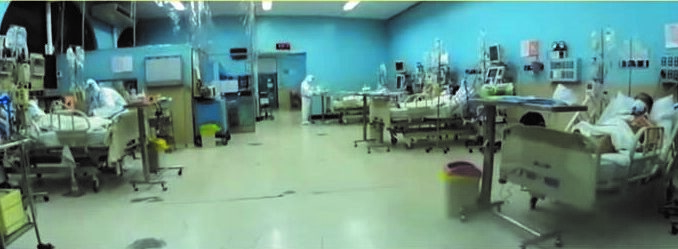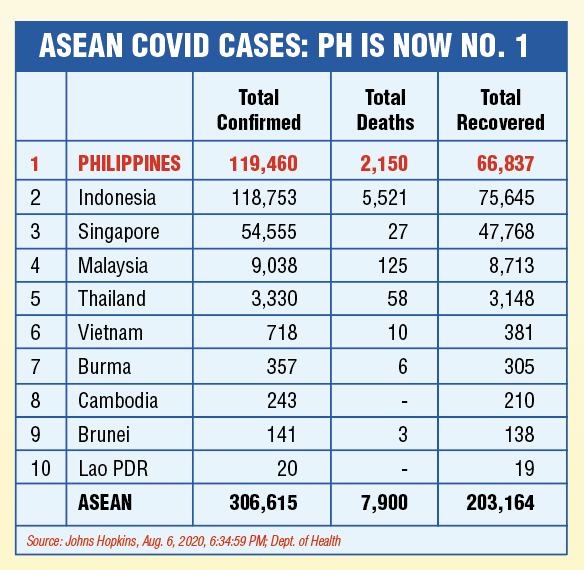
The world’s longest and strictest lockdown has produced the Philippines’ worst Gross Domestic Product (GDP) growth rate in recorded history, a steep 16.5% nosedive in the second quarter of 2020. The 16.5% drop is also the worst performance for any country in the ten-member ASEAN region.
Whole-year reduction in economic production in real terms could be as deep as 8%, about the same as Thailand GDP’s growth drop for the whole of 2020.
During the second quarter, the GDP of Sweden, which did not have a lockdown, contracted by 8.6%, its worst in modern history. Still, that 8.6% slowdown is better than the GDP declines of Spain, 18.5%; Portugal 14.1%, France 13.8%, and Germany, 10.1%. These four Euro countries had lockdowns but not as long and as severe as that of the Philippines.
In ASEAN, Vietnam, with just partial lockdown, saw its economy slowing by just 0.36% in April to June.
It has 717 COVID cases and 9 deaths. Cambodia has 243 cases and zero death; Laos 20 and zero death. Thailand has 3,330 cases and 58 deaths.
The Swedish economy is 1.47x that of Philippines. Its nominal GDP is $528 billion compared to the Philippines’ $356.8 billion.
Sweden has 81,540 COVID-19 cases and 5,760 deaths. The Philippines has had 115,980 cases and 2,123 deaths.

Analysts predict things will get worse for the Philippines and the country will be the COVID hotspot in the region. Expect COVID cases to reach 200,000 in two months with as many as 3,700 deaths.
The Swedish economy, without any lockdown, declined by half our rate. But the Swedes had 2.7x more COVID deaths.
This seems to suggest President Duterte probably saved nearly 2,000 lives with the world’s longest and harshest lockdown.
Saving each of those 2,000 lives cost the economy P820 billion in lost production for just three months, in the second quarter, April to June 2020. During that period, economic production, on the expenditure side in 2018 pesos, amounted to only P4,150.83 billion (P4.15 trillion), down P819.9 billion from the P4,974.73 billion (P4.97 trillion) in the second quarter of 2019. In percentage, the decline was 16.48%.
The decline actually was bigger in current pesos but with inflation, real growth decline looked smaller.
With the economy losing P820 billion in three months but gaining 2,000 in lives saved from COVID during the period, each life was costing the economy P410 million (P820 billion divided by 2,000). Is the value of a Filipino’s life worth that much?
The P410 million is equivalent to $8.2 million. The per capita income of the Filipino is $3,500. Multiply by that 54 years (69, the average life span, minus 15, when a Filipino joins the labor force), you get only $189,000. The amount of $8.2 million (P410 million) is 43.38 times $189,000; it is the premium Duterte pays for each Filipino life he saves, using the longest and most draconian lockdown measures in the world.
If you think Duterte loves you, pray that he will remain our President for a long time. Meantime, you have just lost your job and if you have one, you cannot go to work. Your family is hungry and your kids cannot go to school. Thanks to the lockdown. If you think he is screwing up you up, well, you still have to pray.
If I am to leave my family if I die P410 million, I probably will give it positive thought. You won’t make that much money walking around without mask at Megamall for 6 hours.
However, there is something grievously wrong with our pandemic management or with the economy, or both.
China’s GDP was up 3.2% in the second quarter 2020. South Korea GDP went down just 3.3% in the April to June 2020. Both had only partial and short lockdowns and managed the pandemic quite well.

Economic Planning Secretary Karl Kendrick Chua, who has a masters and doctorate degrees in economics (I took only six units of economics in college and another six units in my MBA class), has an entirely different set of figures on how many people Duterte’s Die-If-You-Don’t (DDYD) lockdown saved.
In infections, it’s 1.3 million to 1.5 million. In number deaths prevented it’s 59,000 to 171,000 lives. But he does not say how he arrived at the numbers.
“The priority was clearly to save lives from COVID-19,” explained Chua. “This decision is worth the lives saved.”

